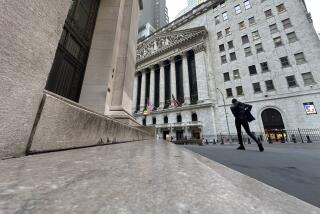Nice bailout. Now what else you got?
- Share via
With uncle sam now about to make good on a $700-billion bailout for the financial system, Wall Street on Friday looked like an ungrateful child.
The stock market began to slide soon after the House approved the bailout bill, and most major market indexes finished the day at new multiyear lows. The Dow Jones industrials slumped 157.47 points, or 1.5%, to 10,325.38 -- its lowest since October 2005.
Thank you, taxpayers!
Already, many big investors are focusing on what else the government might have to do to help the financial system and the economy.
Yes, they want more.
Near the top of the wish list: A new round of interest rate cuts by the Federal Reserve, even though the central bank’s benchmark short-term rate is a measly 2%.
That may be welcomed by home buyers and people with adjustable-rate mortgages. But as usual, savers will eat it.
Congress was warned by the Bush administration that without the bailout, the financial system could collapse and take the economy with it.
But even with the bailout, the markets are in a world of hurt, and any recovery is going to be slow -- because investors’ confidence has been shattered over the last year, and particularly over the last month.
Translation: Your 401(k) statement may not be happy reading for quite a while.
And as taxpayers, we may well be asked to pony up more help for Wall Street, in one form or another.
Understandably, many people still wonder how we got to this point. The simple answer is too much debt, everywhere. Now we’re living through a deleveraging process that has unfolded like a series of earthquakes over the last year, each one bigger than the one before.
The disarray in the credit markets began in July 2007, when investors shocked by rising defaults on subprime mortgages began to pull away from risky debt of all kinds.
The Fed then rode in with interest rate cuts, which made people feel better for a few months.
Then in January of this year, loss-ridden mortgage lender Countrywide Financial was forced to sell out to Bank of America Corp.
In March, brokerage Bear Stearns Cos., a Wall Street institution since 1923, collapsed. In July, IndyMac Bank was seized by the government, in the second-biggest bank failure up to that point.
September brought the biggest quake of all -- the equivalent of the San Andreas fault breaking, in slow motion: In the span of about three weeks, mortgage titans Fannie Mae and Freddie Mac were nationalized, brokerage Lehman Bros. sought bankruptcy protection, Merrill Lynch & Co. was forced into a takeover by Bank of America, American International Group (the largest U.S. insurer) required life support from the Fed, and Washington Mutual, the biggest savings and loan, failed.
If you would have predicted all of this a year ago, no one would have believed you. Or if they had believed you, the assumption probably would have been that the financial system would be crumbling before our eyes -- and with it, investors’ willingness to take even relatively low risks with their money.
And that is where we are: Banks are afraid to lend to one another, even overnight, worried that they won’t get their money back. Those that are lending are demanding rates far above normal.
States and cities have been shut out from normal financing in the municipal bond market because investors won’t buy the securities. Money market mutual funds refuse to buy short-term corporate IOUs, preferring instead to hoard Treasury bills -- knowing that they can at least count on getting their principal back, because the government can always print more money.
The credit markets are frozen with fear. You can say it’s irrational, but given the money that has been lost over the last 12 months by investors who were willing to take risks, it actually looks smarter to be irrational about this than to be rational.
The Bush administration’s plan to blow up the ice floe in the credit markets is to borrow via short-term Treasury securities and use the cash to buy up to $700 billion in bad mortgage debt from banks and other financial institutions.
In theory, that will give those institutions the confidence to start lending again. But it’s only a theory. It will take months to see if it works.
In the meantime, policymakers have to deal with the brutal reality of an economy that is sinking fast, in part because the lack of credit now is squeezing consumers and businesses alike.
The government on Friday reported that the economy lost a net 159,000 jobs in September, the most in five years.
That was one big reason why the stock market couldn’t celebrate, despite getting what it wanted: A huge commitment by the government to throw more money at the crippled credit markets.
Even with the bailout plan, no one can be sure that September’s mega-quake in the financial system won’t be followed by something worse.
Given that uncertainty, the markets’ response is to look for even more help from the only entity big enough to make a difference: Washington.
--
More to Read
Inside the business of entertainment
The Wide Shot brings you news, analysis and insights on everything from streaming wars to production — and what it all means for the future.
You may occasionally receive promotional content from the Los Angeles Times.










